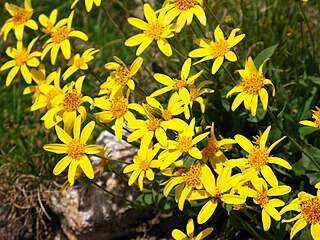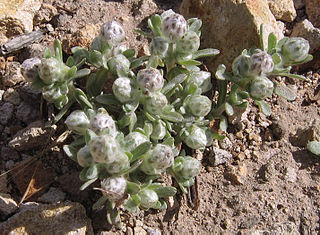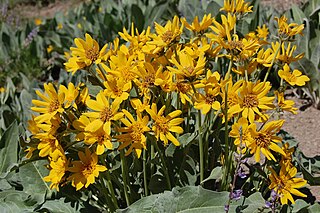
Hazardia squarrosa is a North American species of shrub in the family Asteraceae known by the common name sawtooth goldenbush. It is native to California in the United States and Baja California in Mexico.

Lessingia germanorum is a rare species of flowering plant in the family Asteraceae known by the common name San Francisco lessingia. It is endemic to California, where it is known from four populations in the Presidio of San Francisco and one occurrence on San Bruno Mountain south of San Francisco. It is a state and federally listed endangered species. The already rare plant is endangered by many processes, including invasive species, development, sand mining, off-road vehicles and bulldozers, habitat fragmentation, trampling, and pollution, as well as stochastic events.

Nitrophila mohavensis is a rare species of flowering plant in the family Amaranthaceae known by the common name Amargosa niterwort. It is endemic to Nye County in southwestern Nevada and Inyo County, in eastern California.
Pseudobahia bahiifolia is a rare species of flowering plant in the family Asteraceae known by the common name Hartweg's golden sunburst.
Pseudobahia peirsonii is a rare species of flowering plant in the family Asteraceae known by the common names San Joaquin adobe sunburst and Tulare pseudobahia. It is endemic to California, where it is known from a few mostly small occurrences along the southeastern side of the San Joaquin Valley where it rises into the Sierra Nevada foothills. It grows in grassland and oak woodland habitat. It prefers heavy adobe clay soils. The plant became a federally listed threatened of the United States in 1997.

Pyrrocoma apargioides is a species of flowering plant in the family Asteraceae known by the common name alpineflames. It is native to the western United States from the Sierra Nevada of California east to Utah, where it grows in the forests and meadows of high mountains. It is a perennial herb growing from a taproot and producing one or more stems to 30 centimeters in length. The stems are decumbent or upright, reddish, and hairless to slightly woolly. Most of the leaves are located around the base. They are thick and leathery, lance-shaped with large sawteeth along the edges, often center-striped in white, and measure up to 10 centimeters long. The inflorescence is usually a single flower head lined with centimeter-long phyllaries which are reddish to green with red edges. The head has a center of yellow disc florets and a fringe of ray florets which are yellow, often splashed with red along the undersides, measuring up to 1.6 centimeters in length. The fruit is an achene which may be well over a centimeter in length including its pappus.

Pyrrocoma carthamoides is a species of flowering plant in the family Asteraceae known by the common name largeflower goldenweed. It is native to western North America from British Columbia to northeastern California to Wyoming, where it is known from grassland, woodlands, forests, barren areas, and other habitat. It is a perennial herb growing from a taproot and producing one or more stems to about half a meter in maximum length, the stems reddish-green and leafy. The largest leaves are at the base of the stem, measuring up to 20 centimeters long, lance-shaped with spiny sawtoothed edges. Leaves higher on the stem are smaller and hairier. The inflorescence is a single flower head or a cluster of up to four. Each bell-shaped head is lined with phyllaries each up to 2 centimeters long. It has many yellow disc florets surrounded by a fringe of yellow ray florets up to 7 millimeters long; ray florets are occasionally absent. The fruit is an achene which may be well over a centimeter in length including its pappus.

Pyrrocoma lanceolata is a species of flowering plant in the family Asteraceae known by the common name lanceleaf goldenweed. It is native to western North America from central Canada to northeastern California to Colorado, where it grows in many types of habitat, including disturbed places and areas with wet, alkali soils. It is a widespread and variable plant. It is a perennial herb growing one or more stems up to about half a meter long. The stems are decumbent or upright, reddish, usually somewhat hairy to quite woolly, and glandular toward the ends of the stems. The largest leaves are at the base of the plant, each measuring up to 30 centimeters in maximum length. They are generally lance-shaped with sawtoothed edges. The inflorescence bears several, up to 50, flower heads lined with reddish to green phyllaries. Each contains yellow disc florets and ray florets. The fruit is an achene up to a centimeter long including its pappus.

Pyrrocoma lucida is a species of flowering plant in the family Asteraceae known by the common names sticky goldenweed and sticky pyrrocoma. It is endemic to California, where it is known only from the northern Sierra Nevada. It grows in mountain forests and clay flats with alkali soils. This is a perennial herb growing from a taproot, producing an erect stem up to 75 centimetres (30 in) tall. It is hairless and glandular, its surface resinous and shiny. The leaves are lance-shaped with sharply toothed edges, the largest near the base of the stem reaching 25 centimetres (10 in) in length. Smaller leaves up to 10 centimetres (4 in) long occur higher on the stem. The inflorescence is a narrow spikelike array of many flower heads lined with thick, overlapping, gland-dotted phyllaries. Each head contains up to 40 yellow disc florets surrounded by a fringe of up to 20 yellow ray florets. The fruit is an achene up to a centimeter long including its pappus.

Pyrrocoma racemosa is a species of flowering plant in the family Asteraceae known by the common name clustered goldenweed. It is native to the western United States, where it grows in many types of habitat. It is quite variable in morphology, and there are several varieties which are sometimes hard to tell apart. In general, it is a perennial herb usually producing two or more mostly erect stems reaching maximum heights between 15 and 90 centimeters. The stems are reddish or brownish in color, leafy or not, and hairless to quite woolly. The longest leaves are located in tufts around the base of the stems. They are lance-shaped to oval, smooth-edged, wavy, or deeply spine-toothed, and may exceed 30 centimeters in length. Basal leaves are borne on woolly petioles. Leaves located higher on the stem lack petioles and may clasp the stem at their bases. The inflorescence is a cluster of several flower heads lined with phyllaries which may be over a centimeter long and are hairy to hairless in texture. Each head contains many yellow disc florets and a fringe of several yellow ray florets. The fruit is an achene which may be over a centimeter long including its pappus.
Senecio clarkianus is a species of flowering plant in the aster family known by the common name Clark's ragwort. It is endemic to the Sierra Nevada of California, where it grows in the moist meadows on the western slopes of the range. It is a perennial herb growing up to 1.2 meters tall from a caudex and fibrous root system. The solitary erect stem is lined evenly with leaves up to about 18 centimeters long, their blades deeply lobed or dissected into narrow, pointed segments. The herbage is hairy to woolly in texture. The inflorescence bears several flower heads which are lined with green-tipped phyllaries. They contain many yellow disc florets and each has usually 8 or 13 narrow yellow ray florets about a centimeter long, sometimes longer.

Senecio hydrophiloides is a species of flowering plant in the aster family known by the common names tall groundsel and sweet marsh ragwort. It is native to western North America from British Columbia and Alberta to northern California to Utah, where it grows in wet meadows and similar habitat. It is a biennial or perennial herb producing a single erect stem or a cluster of a few stems which may exceed one meter in maximum height. The plants are green to red in color and usually without hairs, but new growth can be woolly. The leaves are lance-shaped to oval with toothed edges, the blades up to 25 centimeters long and borne on long winged petioles. The leaves are firm and sometimes a bit fleshy. The inflorescence is a loose or dense cluster of up to 30 or more flower heads lined with black-tipped phyllaries. They contain many yellowish disc florets at the center and often have some yellow ray florets, though these are sometimes absent. Senecio Hydrophiloides can cause Dermatitis.

Packera werneriifolia, known by the common names alpine rock butterweed and hoary groundsel, is a species of flowering plant in the aster family. It is native to the western United States in the Sierra Nevada mountain habitat in subalpine and alpine climates, including forests and barren talus.

Stylocline gnaphaloides is a species of flowering plant in the aster family known by the common names mountain neststraw and everlasting neststraw.

Tetradymia stenolepis is a species of flowering plant in the aster family known by the common name Mojave cottonthorn. It is native to the deserts around the intersection of Arizona, Nevada, and eastern California, where it grows in woodland and scrub habitat on sandy and gravelly substrates. It is a bushy shrub with many branches coated in woolly white fibers and growing to a maximum height just over a meter. The narrow leaves are 2 or 3 centimeters long and harden into straight, sharp spines. Clusters of woolly leaves grow near the spines. The inflorescence bears up to 7 flower heads which are each enveloped in four or five woolly phyllaries. Each head contains up to four or five tubular yellow flowers each around a centimeter long. The fruit is a hairy achene which may be nearly 2 centimeters long, including its pappus of long bristles.

Thelypodium stenopetalum is a rare species of flowering plant in the mustard family known by the common names slenderpetal thelypody, slender-petaled thelypodium and slender-petaled mustard. It is endemic to the San Bernardino Mountains of southern California, where it is known from only three or four extant occurrences in moist mountain meadows near Big Bear Lake. Its remaining habitat is considered seriously threatened and the plant is a federally listed endangered species in the United States.

Wyethia mollis is a species of flowering plant in the family Asteraceae known by the common name woolly mule's ears. The plant is hairy to woolly in texture, sometimes losing its hairs with age.

Potentilla villosa is a species of flowering plant in the rose family, Rosaceae. Its common names include villous cinquefoil, northern cinquefoil, and hairy cinquefoil. It is native to northwestern North America, where its distribution extends from Alaska to Alberta to Oregon. There are records from eastern Asia.

Pyrrocoma clementis is a species of flowering plant in the family Asteraceae known by the common name tranquil goldenweed. It is native to Colorado, Utah, and Wyoming in the United States.

Grindelia fraxinipratensis, common name Ash Meadows gumweed, is a North American species of flowering plants in the family Asteraceae. It is native to the southwestern United States, in Mojave Desert regions in Nye County in Nevada and Inyo County in California. Some of the Nevada populations lie inside the Nevada Test Site of the United States Atomic Energy Commission


















